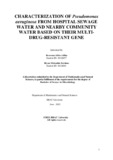Characterization of pseudomonas aeruginosa from hospital sewage water and nearby community water based on their multi-drug-resistant gene
Abstract
Introduction: Hospital wastewater is one of the most prominent sources of antibiotic-resistant
pathogenic bacteria. This study aims to find multi-drug-resistant Pseudomonas aeruginosa
from the hospital and nearby community water to find the organisms with Multidrug-resistant
genes from hospital wastewater that get to mix with community water.
Method: The study was conducted with samples from November 2022 to March 2023 and a
total of 43 different isolates of Pseudomonas aeruginosa were collected from hospital
wastewater and surrounding community tap water. Firstly, the phenotype technique was used
to identify the multi-drug resistant isolates. Further, following the Kirby-Bauer disk diffusion
method, an antibiotic susceptibility test was performed. To identify the resistant gene of ESBL
(Extended spectrum β-lactamase) and MBLS (Metallo-beta-lactamase) PCR method is further
performed.
Result: A Total 65 Number of samples were collected from Three Hospital and their adjacent
community water and Confirmed isolates of Pseudomonas aeruginosa were found in 43 of
those 65 samples. The percentage of confirmed isolates is 27.95%. These 43 isolates were
found resistant to Amikacin (15%), Tetracycline (46%), Amoxiclav (93%), Azithromycin
(48%), Aztreonam (65%), Cefepime (32%), Cefixime (32%), Ceftazidime (100%),
Chloramphenicol (11%), Ciprofloxacin (13%), Gentamicin (3%), Imipenem (11%). After that,
7 isolates were selected for further identification of Multidrug-resistant-Gene. The presence of
NDM-1 was found in 3 isolates, bla TEM was found in 4 isolates, and bla VIM was found in one
isolate after performing the PCR method using these 8 Genes.
Conclusion: In our study 43 target Pseudomonas aeruginosa confirmed isolates were found
and among them 24 were hospital isolates and 19 were community isolates. 7 MDR isolates
were selected, among them 4 isolates, 3 isolates, and 1 isolate positive for respectively blaTEM,
NDM- 1, and bla VIM genes. This scenario shows how hospital waste contains organisms with
resistant patterns and transmitting MDR microorganisms to nearby community water and
spreading MDR genes. It is becoming a serious threat to the environment and public health, so
it requires proper maintenance of hospital disposal to the environment and need proper methods
to prevent these strains.

